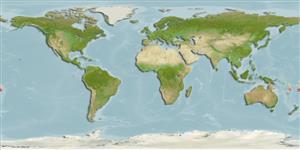Klassifizierung / Names
Namen | Synonyme | Catalog of Fishes(Gattung, Arten) | ITIS | CoL | WoRMS | Cloffa
>
Gobiiformes (Gobies) >
Gobiidae (Gobies) > Gobiinae
Etymology: Trimma: Greek, trimma, -atos = something crushed (Ref. 45335); finistrinum: Name from the Greek 'finistrini' (φινιστρίνι), ) meaning a porthole, referring to the lines of yellow
spots along the sides of the body, reminiscent of the lighted portholes of an ocean liner at night; noun in apposition.
Environment: milieu / climate zone / Tiefenbereich / distribution range
Ökologie
seewasser riff-verbunden; tiefenbereich 11 - 20 m (Ref. 115117). Tropical
Verbreitung
Länder | FAO Gebiete | Ecosystems | Vorkommen | Punkt Karte | Einführungen | Faunafri
Western Central Pacific: Fiji.
Size / Gewicht / Alter
Geschlechtsreife: Lm ? range ? - ? cm
Max length : 2.5 cm SL Männchen/unbestimmt; (Ref. 115117); 2.1 cm SL (female)
Kurzbeschreibung
Bestimmungsschlüssel | Morphologie | Morphometrie
Rückenflossenstacheln (insgesamt) : 7; Rückenflossenweichstrahlen (insgesamt) : 8; Afterflossenstacheln: 1; Afterflossenweichstrahlen: 8. This species is distinguished by the following characters: bony interorbital 100% pupil diameter; fully scaled midline of nape of 12-14 scales; the second dorsal spine may reach posteriorly to middle of second dorsal fin; papillae in longitudinal row immediately below eye either single or with two papillae in vertical row (but not in vertical rows of 3-5 papillae at each position); pectoral-fin rays unbranched; usually a branched fifth pelvic-fin ray that is about half length of the fourth ray; a large diffuse dark blotch on the posterior caudal peduncle; colour pattern of a brownish body with most body scales having golden- to greenish-yellow (pale in preservative) centres is unique among species of Trimma (Ref. 115117).
Body shape (shape guide): elongated; Cross section: oval.
Life cycle and mating behavior
Geschlechtsreife | Fortpflanzung | Ablaichen | Eier | Fecundity | Larven
Winterbottom, R., 2017. Two new species of Trimma (Pisces; Gobiidae) from Fiji, south-western Pacific Ocean. Zootaxa 4269(4):559-570. (Ref. 115117)
IUCN Rote Liste Status (Ref. 130435: Version 2025-1)
Bedrohung für Menschen
Harmless
Nutzung durch Menschen
Fischereien: nicht kommerziell
Tools
Zusatzinformationen
Download XML
Internet Quellen
Estimates based on models
Phylogenetic diversity index (Ref.
82804): PD
50 = 0.5000 [Uniqueness, from 0.5 = low to 2.0 = high].
Bayesian length-weight: a=0.00724 (0.00339 - 0.01546), b=3.10 (2.92 - 3.28), in cm total length, based on LWR estimates for this (Sub)family-body shape (Ref.
93245).
Widerstandsfähigkeit (Ref.
120179): hoch, Verdopplung der Population dauert weniger als 15 Monate. (Preliminary K or Fecundity.).
Fishing Vulnerability (Ref.
59153): Low vulnerability (10 of 100).
🛈
